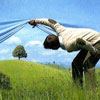On The Nature Of Our Greater Reality
 By Jane Roberts
By Jane Roberts
You must first of all understand that your own greater reality exists whether you are in flesh or out of it, and that your subjective experience has a far greater scope than the physical brain itself allows.
The blueprints for reality will not be found in the exterior universe. Some other civilizations experimented with a different kind of science than the one with which you are familiar. They met with varying degrees of success in their attempts to understand the nature of reality, and it is true that their overall goals were different than yours. Such people were focusing their consciousnesses in a completely different direction. Your own behavior, customs, sciences, arts, and disciplines are in a way uniquely yours, yet they also provide glimpses into the ways in which various groupings of abilities can be used to probe into the “unknown” reality.
Art is as much a science, in the truest sense of the word, as biology is. Science as you think of it separates itself from the subject at hand. Art identifies with the subject. In your terms, then, other civilizations considered art as a fine science, and used it in such a way that it painted a very clear-cut picture of the nature of reality—a picture in which human emotion and motivation played a grand role.
Your scientists spend many long years in training. If the same amount of time were spent to learn a different kind of science, you could indeed discover far more about the known and unknown realities. There are some individuals embarked upon a study of dreams, working in the “dream laboratories”; but here, again there is prejudiced perception, with scientists on the outside studying the dreams of others, or emphasizing the physical changes that occur in the dream state. The trouble is that many in the sciences do not comprehend that there is an inner reality. It is not only as valid as the exterior one, but it is the origin for it. It is that world that offers you answers, solutions, and would reveal many of the blueprints that exist behind the world of your experience.
The true art of dreaming is a science long forgotten by your world. Such an art, pursued, trains the mind in a new kind of consciousness—one that is equally at home in either existence, well-grounded and secure in each. Almost anyone can become a satisfied and productive amateur in this art-science; but its true fulfillment takes years of training, a strong sense of purpose, and a dedication—as does any true vocation.
To some extent, a natural talent is a prerequisite for such a true dream-art scientist. A sense of daring, exploration, independence, and spontaneity is required. Such a work is a joy. There are some such people who are quite unrecognized by your societies, because the particular gifts involved are given zero priority. But the talent still exists.
A practitioner of this ancient art learns first of all how to become conscious in normal terms, while in the sleep state. Then he becomes sensitive to the different subjective alterations that occur when dreams begin, happen, and end. He familiarizes himself with the symbolism of his own dreams, and sees how these do or do not correlate with the exterior symbols that appear in the waking life that he shares with others.
There are inner meeting places, then, interior “places” that serve as points of inner commerce and communication. In a completely different context, they are quite as used as any city or marketplace in the physical world. Our dream-art scientist learns to recognize such points of correlation.
In a manner of speaking, they are indeed learning centers. Many people have dreams in which they are attending classes, for example, in another kind of reality. Whether or not such dreams are “distorted,” many of them represent a valid inner experience. All of this, however, is but a beginning for our dream-art scientist, for he or she then begins to recognize the fact of involvement with many different levels and kinds of reality and activity. He must learn to isolate these, separate one from the other, and then try to understand the laws that govern them. As he does so, he learns that some of these realities nearly coincide with the physical one, that on certain levels events become physical in the future, for example, while others do not. He is then beginning to glimpse the blueprints for the world that you know.
Now: You manufacture articles. It has taken you centuries to reach your point of technological achievement. It seems to you then that objects come from the outside, generally speaking—for after all, do you not make them in your factories and laboratories?
In a way it seems that “artificial” or synthetic fabrics are not natural. You produce them from the outside. Yet your world is composed of quite natural products, objects that emerge, almost miraculously when you think of it, from the inside the earth.
You work with material that is already there, provided. You mix, change, and rearrange what is already given. The entire physical universe emerges from an inside, however, and none of your manufacture would provide you with even one object, were it not for those that appeared as source materials long before. Wood, plants, all the species of the earth, the seasons and the planet itself, come from this unidentifiable inside. Physical events have the same source.
The true scientist understands that he must probe the interior and not the exterior universe; he will comprehend that he cannot isolate himself from a reality of which he is a necessarily a part, and that to do so presents at best a distorted picture. In quite true terms, your dreams and the trees outside of your windows have a common denominator: they both spring from the withinness of consciousness.
Simply as an analogy, look at it this way: Your present universe is a mass-shared dream, quiet valid—a dream that presents reality in a certain light; a dream that is above all meaningful, creative, based not upon chaos (with a knowing look), but upon spontaneous order. To understand it, however, you must go to another level of consciousness—one where, perhaps, the dream momentarily does not seem so real. There, from another viewpoint, you can see it even more clearly, holding it like a photograph in your hands, at the same time you can see from that broader perspective that you do indeed also stand outside of the dream context, but in a “within” that cannot show in the snapshot because of its limitations.
The outsideness of the physical world is connected, then, with a multidimensional “insideness.” That exterior world is thrust outward, however, and projected into reality in line with your conscious desires, beliefs, and intent. It is important that you remember this position of the conscious mind as you think of it. Each physical experience is unique, and while the energy for it and the creation of it come from within, the pristine, private, and yet shared quality of that experience could not exist in the same way (more emphatically) were it not so exteriorized.
Nevertheless, the blueprints lie within. There are other important ways that could be used to study the nature of reality. One in particular does not involve the dream state per se. It does include the manipulation of consciousness, however. To some extent it includes identification with, rather than separation from, that which is being studied.
While connected with your own civilization, the man Einstein came closest perhaps in this regard, for he was able to quite naturally identify himself with various “functions” of the universe. He was able to listen to the inner voice of matter. He was intuitively and emotionally led to his discoveries. He leaned against time, and felt it give and wobble.
The true [mental] physicist will be a bold explorer—not picking at the universe with small tools, but allowing his consciousness to flow into the many open doors that can be found with no instrument, but with the mind.
Your own consciousness as you think of it, as you are familiar with it, can indeed help lead you into some much greater understanding of the simultaneous nature of time if you allow it to. You often use tools, instruments, and paraphernalia instead—but they do not feel time, in those terms. You do. Studying your own conscious experience with time will teach you far more.
You are presently little aware of the dimensions of consciousness—your own or those seemingly “beneath” your own. The true physicist is one who would dare turn around inside his own consciousness.
There are inner structures within matter. These are swirls of energy. They have more purposes than one. The structures are formed by organizations of consciousness, or CU’s. You have the most intimate knowledge of the nature of a cell, for example, or of an atom. They compose your flesh. There is, in certain terms, a continuum of consciousness there of which your present physical life is a part. You are in certain kinds of communication and communion with your own cells, and at certain levels of consciousness you know this. A true physicist would learn to reach that level of consciousness at will. There were pictures drawn of cellular structures long before any technological methods of seeing them were available, in your terms.
There are shapes and formations that appear when your eyes are closed that are perfect replicas of atoms, molecules, and cells, but you do not recognize them as such. There are also paintings—so-called—abstracts unconsciously produced, many by amateurs, that are excellent representations of such inner organizations.
Ruburt has at times been able to throw his consciousness into small physical instruments (computer components, for instance) and to perceive their inner activity at the level of, say, electrons. Given time, in your terms, a knowledge of the structure of so-called particles could be quite as clearly understood by using such techniques. Now, however, your terms would not match. Yet your terms are precisely what imprison you, and lead you to the “wrong” kinds of questions.
The wrong kinds of questions are the right ones for you, however, in your civilization and with your beliefs, because you want to stay within that structure to that extent. Only now are you beginning to question your methods, and even your questions. The true physicist would be able to ask his questions from his usual state of consciousness, and then turn that consciousness in other directions where he himself would be led into adventures-with-reality, in which the questions would themselves be changed. And then the answers would be felt.
But most physicists do not trust felt answers. Feeling is thought to be far less valid than a diagram. It seems you could not operate your world on feelings—but you are not doing very well trying to operate with diagrams, either!
In many cases your scientists seem to have the strange idea that you can understand a reality by destroying it; that you can perceive the life mechanism of an animal by killing it; or that you can examine a phenomenon best by separating yourself from it. So, often, you attempt to examine the nature of the brain in man by destroying the brains of animals, by separating portions of the animal brain from its components, isolating them, and tampering with the overall integrity of both the animal in question and of your own spiritual processes. By this I mean that each such attempt puts you more out of context, so to speak, with yourself and your environment, and other species. While you may “learn” certain so-called facts, you are driven still further away from any great knowledge, because the so-called facts stand in your way. You do not as yet understand the uniqueness of consciousness.
It is absurd to believe that you can learn something about consciousness by destroying it. It is absurd to believe that you can learn one iota about the inner reality of life when your search leads you to destroy it. Destruction, you see, in your terms presupposes a misunderstanding of life to begin with.
There are ways of identifying with animals, with atoms and molecules. There are ways of learning from the animals. There are methods that can be used to discover how different species migrate, for example, and then to duplicate such feats technologically if you want to. These methods do not include dissection, for what you learn that way you will not be able to use.
Even in terms of history and serial time, as a race you have tried various methods of dealing with the physical world. In this latest venture you are discovering that exterior manipulation is not enough, that technology alone is not “the answer.” Please understand me: There is nothing wrong with a loving technology.
If Einstein had been a better mathematician, he would not have made the breakthroughs that he did. He would have been too cowed. Yet even then his mathematics did hold him back, and put a kink in his intuitions. Often you take it for granted that intuitive knowledge is not practical, will not work, or will not give you diagrams. Those same diagrams of which science is so proud, however, can also be barriers, giving you a dead instead of a living knowledge. Therefore, they can be quite impractical.
If you did not feel the need to kill animals to gain knowledge, then you wold not have wars, either. You would understand the balances of nature far better.
If you did not feel any need to destroy reality (in your terms) in order to understand it, then you would not need to dissect animals, hoping to discover the reasons for human diseases. You would have attained a living knowledge long ago, in which diseases as such did not occur. You would have understood long ago the connections between mind and body, feelings, health, and illness.
I am not saying that you would have necessarily had a perfect world, but that you would have been dealing more directly with the blueprints of reality.
Excerpt from The “Unknown” Reality
Posted in Other Topics, Science For The New Agewith comments disabled.





